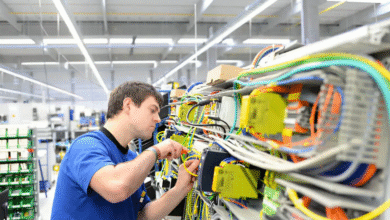What Is Pigging? A Modern Maintenance Technique That Keeps Pipelines Flowing

In industries where fluids, gases, or other substances travel through pipelines, operational efficiency and safety are top priorities. Over time, even the most well-constructed pipelines can suffer from buildup, contamination, or structural issues. This is where pigging comes into play. If you’ve been asking what is pigging this article will give you a clear and in-depth understanding of the concept, its applications, benefits, and how it has become a critical process across multiple industries.
What Is Pigging?
At its core, pigging refers to the process of inserting a device—called a pig—into a pipeline to perform tasks such as cleaning, inspecting, separating fluids, or recovering product. The pig travels through the pipeline, usually pushed by the product flow or compressed air, without stopping normal operations.
The term “pigging” might sound unusual, and many believe it originated from the squealing noise early mechanical pigs made as they scraped through pipelines. Despite the name, pigging is a sophisticated and highly valuable method of pipeline maintenance.
The Purpose Behind Pigging
Understanding what is pigging also means understanding why it’s done. Pipelines, whether in the oil, gas, chemical, water, or food sectors, need to remain clean and functional to avoid inefficiencies, contamination, or damage.
Here are the main reasons for pigging:
- Cleaning: Remove debris, scale, wax, or other deposits that reduce flow efficiency.
- Inspection: Detect cracks, corrosion, or other structural issues inside the pipeline.
- Separation: Keep different products (e.g., gasoline and diesel) from mixing during batch transfers.
- Product Recovery: Push valuable leftover product to the end of the line, minimizing waste.
In modern industry, pigging has evolved from a manual, mechanical process to a highly automated and intelligent operation, thanks to advancements in sensors, data logging, and control systems.
See also: Exploring the Role of 7737025564 in New Age Tech Solutions
How the Pigging Process Works
To better understand what is pigging, it’s important to know how the process is carried out:
1. Insertion via Pig Launcher
A pig is inserted into a section of the pipeline called the pig launcher. This device is typically a Y-shaped chamber where the pig is loaded without shutting down the pipeline. Once inside, the launcher is sealed.
2. Propulsion Through the Pipeline
The pig is propelled forward by the pressure of the product being transported (e.g., oil or gas) or by a separate source of pressure like nitrogen or air. As it moves, it performs its intended function—whether it’s scraping residue, scanning for defects, or pushing one product out of the way of another.
3. Tracking the Pig
Operators often use pig tracking systems (e.g., radio transmitters or magnetic detectors) to monitor the pig’s position as it travels. This ensures it reaches the intended receiver without obstruction.
4. Collection at Pig Receiver
At the other end of the line, a pig receiver safely captures the pig so it can be removed, examined, and possibly reused or replaced.
Types of Pigs Used in Pigging
Understanding what is pigging also means recognizing the different types of pigs involved. These include:
- Foam Pigs: Lightweight and flexible, ideal for drying or low-pressure cleaning tasks.
- Cup or Disc Pigs: Used for cleaning and pushing liquids or debris with strong sealing power.
- Brush Pigs: Equipped with wire or nylon brushes for aggressive cleaning.
- Smart Pigs: High-tech devices that inspect the pipeline interior using tools like magnetic flux leakage or ultrasonic sensors.
- Gel Pigs: A semi-liquid pig that conforms to pipeline shapes, used in sensitive or complex systems.
- Spherical Pigs: Rubber balls used to displace liquids or separate products in gas pipelines.
Each pig type is chosen based on the pipeline’s content, condition, and operational requirements.
Industries That Use Pigging
Pigging is used across many sectors, each with its own set of goals and challenges. Here are a few industries where pigging is a routine practice:
1. Oil and Gas
This is the most common sector for pigging. Pipelines that transport crude oil, refined fuels, or natural gas are regularly pigged to maintain flow efficiency and detect early signs of corrosion or leaks.
2. Chemical Manufacturing
Pigging helps avoid contamination between different chemical batches and ensures lines remain clean, reducing safety risks and operational errors.
3. Food and Beverage
Hygienic pigging systems are designed to meet sanitary standards and recover high-value food or beverage products (such as sauces, creams, and juices), minimizing waste and maximizing profitability.
4. Water Utilities
Municipal and industrial water systems use pigging to clear sediment, biological buildup, and air pockets that affect water pressure or quality.
5. Pharmaceuticals
Pigging is used in clean-in-place (CIP) systems to meet strict hygiene standards, ensuring the product remains uncontaminated and the lines are thoroughly cleaned.
Benefits of Pigging
Now that you have an idea of what is pigging, let’s look at the benefits that make it so important in modern operations:
- Improved Efficiency: Clean pipelines mean reduced friction, which lowers pumping costs and increases throughput.
- Waste Reduction: Pigging recovers residual product that would otherwise be lost, especially valuable in the food and chemical sectors.
- Extended Pipeline Life: Removing corrosive elements and spotting damage early helps extend the operational lifespan of pipelines.
- Non-Intrusive Maintenance: Most pigging processes don’t require shutting down the line, allowing for continuous operation.
Pigging and the Future of Pipeline Maintenance
As industries continue to embrace automation, digitization, and environmental responsibility, pigging is evolving too. Smart pigs are now equipped with real-time data transmission, artificial intelligence, and predictive analytics. This allows operators to detect micro-cracks, map pipeline geometry, and plan maintenance schedules more accurately than ever before.
Sustainable pigging practices are also emerging. For example, biodegradable pigs and low-energy systems are being developed to align with environmental goals while maintaining efficiency.
Final Thoughts
So, what is pigging? It’s more than just pushing a device through a pipe—it’s a critical maintenance and inspection strategy that helps industries maintain safety, reduce waste, improve efficiency, and extend the life of their infrastructure. Whether it’s cleaning a gas line, separating chemical batches, or inspecting for corrosion, pigging is a powerful tool that continues to evolve with technological and industrial advancements.
As global pipeline networks expand and become more complex, pigging will remain an essential practice—quietly ensuring that the fluids and gases powering our world move swiftly, safely, and sustainably.



